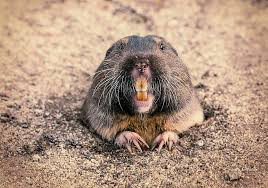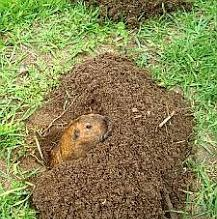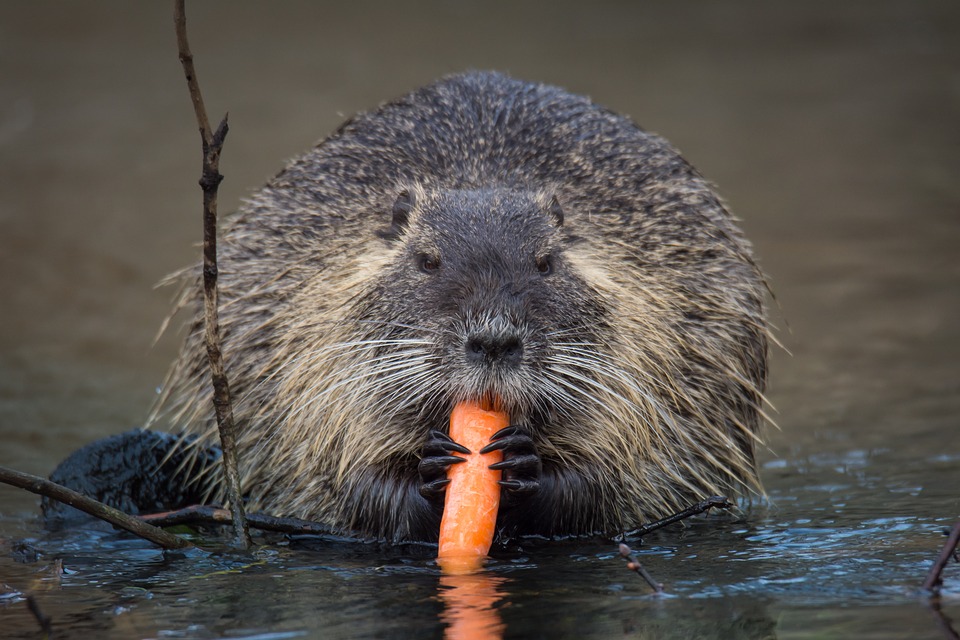Do you encounter any tunnel system (ref. below fig.) of some 18 inches below ground and some fresh mounds all over your landscape? Then these are definitely done by a rodent called GOPHER, commonly referred to as Pocket Gopher.

Let’s get introduced to this tiny critter creating a great havoc in the backyards.

Gophers fall under order Rodentia commonly known for their extensive tunneling activities. The 35 species of gophers live in habitat such as woodlands, grass prairies, coastal to mountainous regions. They spend their days building complex underground tunnels in the areas having soft soil and abundance of food availability.
Gophers are attracted to moist, light-textured soil with edible vegetation. Their main runways are located up to 18 inches below the surface, though their nesting chambers are much deeper, often six feet below the surface.
Gophers are the notorious hoarders. They carry their food in cheek pouches and stockpile astounding amount of food in the huge underground settlements, hence the name pocket gophers.

Gophers are the omnivorous species and feed on nuts, berries, grass, leaves and insects.Gophers are small creatures of 5 to 12 inches. They have their front feet long, sharp claws useful for burrowing. Their hairy tails are four inches long useful to navigate through tunnels when moving backwards.
They create fan-shaped mounds that are large enough to damage irrigation systems, dams, fields and of course homeowners’ lawns and gardens. Following are the pieces of evidence explaining the damage.
Gophers slowing construction in Thurston County
Posted 12:36 pm, April 26, 2017
The Mazama pocket gopher is listed as threatened in Thurston County, and that is putting the construction on hold, regardless of what property owners may want.
“They have more rights to our property than we do,” Deborah Mclain told Q13.
“In one instance, I had to give up 64% of my property where we built the house,” homebuilder Larry Weaver said. “It was a little over an acre of ground, and 64% had to be fenced off as gopher habitat.”
‘Pest’ pocket gophers to be killed off
By Daniel J. Chacón, The New Mexican, Jan 10, 2017
The city of Santa Fe is going on a killing spree.
Hundreds, possibly thousands, of pocket gophers are the target.
The little critters — rodents, really — have infested two parks in the south-central part of the city, dotting them with dirt mounds and, according to city officials, compromising irrigation lines, ruining the turf and making the areas unsafe for sports and other recreational activities.
“Go to Franklin Miles, and you can see that it looks like thousands of little landmines have exploded, and that’s throughout the entire park,” Trujillo said Tuesday. “These pocket gophers dig.”
“Pocket gophers are not protected by any state or federal law or local ordinance,” said Victor Lucero, manager of the city’s integrated pest management program. “They’re not considered endangered. They are a rodent pest.”
“One pocket gopher has the potential to create 60 mounds in the course of one month,” he said.
Pocket gophers – No. 1 enemy in subsurface drip irrigation in western alfalfa
Cary Blake | Dec 31, 2015
The continued farming skirmish pits western alfalfa growers – who want to upgrade from traditional surface irrigation systems to more water efficient subsurface drip irrigation (SDI) systems – against vertebrate pests, mainly pocket gophers, which chew up underground SDI drip tape.
While the stakes are high and producers have an upper hand, gophers remain the No. 1 enemy.
“Rodents are undoubtedly the major challenge for SDI in alfalfa in northern California,” said Dan Putnam, University of California Extension alfalfa and forage specialist based at Davis.
Are you now aware of the Gophers nuisance? Then let think for the solution and which is provided by CTech Corporation’s product RODREPELTM
The evidence shows the havoc created by gophers and it so great that people tried to kill them by using insecticides. Killing the animal is not an economically and environmentally feasible solution.
CTech Corporation provides you with an eco-friendly solution against gophers. Our product RodrepelTM is an extremely low toxic, extremely low hazard, non-mutagenic anti-rodent, anti-animal aversive repellent. It can be effectively used against gophers and other similar damage causing rodents like voles, moles, rats, etc.
RodrepelTM is the product manufactured on the basis of green technology. Our product is RoHS, RoHS2, ISO, EU BPR complaint, and FIFRA exempted which proves are low toxicity and environment safety concerns.
RodrepelTM is available in the form of masterbatch, liquid concentrate and lacquer.
RodrepelTM Masterbatch is incorporated while processing in polymer-based products such as drip irrigation pipes, electric supply cables, etc.
RodrepelTM Liquid concentrate is to be mixed in paints in proper proportion and RodrepelTM lacquer is a direct topcoat application which can be applied on fences, installed products, walls, etc.
If you are facing nuisance caused by rodents, write about it to us at technical.marketing@ctechcorporation.com
Also, visit our websites:
http://www.ctechcorporation.com/
http://www.rodrepel.com/
http://www.termirepel.com/
http://www.combirepel.com/
Follow our Facebook pages at:
1] https://www.facebook.com/Combirepel-411710912249274/
2] https://www.facebook.com/Termirepel-104225413091251/
3] https://www.facebook.com/Rodrepel-120734974768048/
Follow us on our Twitter pages at:
1] https://twitter.com/rodrepel
2] https://twitter.com/termirepel
3] https://twitter.com/combirepel






